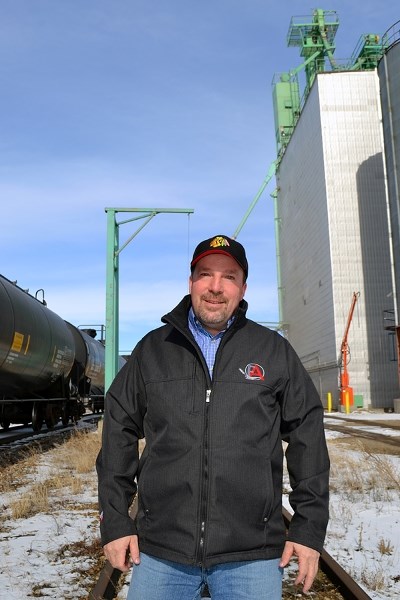And now there are two.
Less than two weeks after the news that GrainsConnect Canada, a newcomer to the grain handling industry, is building the first-ever high throughput grain terminal operation in Red Deer County at Niobe, a second is following close behind.
On Feb. 29, Paterson Grain, which has served western Canadian farmers for more than a century, announced it's constructing a second gigantic facility for the region just outside the Town of Bowden.
“It is a huge positive for grain producers in this part of the province. For a while there I thought we were the forgotten sisters with all those other terminals that have been built in the last few years,” said Jason Lenz, who is vice-chairman of Alberta Barley, a farmer-directed, not-for-profit organization representing provincial barley farmers.
“To have the GrainsConnect announcement, and now with the super terminal at Bowden, it is going to be a huge financial benefit for us as grain producers as it allows more competition for our grain.”
Paterson Grain said its new inland export terminal near Bowden, the company's fourth in Alberta, will have a 55,000-metric-tonne storage capacity and will utilize a loop track to load up to 150 cars in seven hours, specifications that are even larger and faster than the planned facility at Niobe, two kilometres north of Innisfail. Bowden, which is served by Canadian Pacific Railway (CP), has one other elevator, a 1,200-tonne- capacity site operated by grain handler and pulse processor W.A. Grain.
In a news release, the company said grain originating from the Bowden facility would be exported worldwide through Paterson's terminal in the Port of Vancouver.
“It will be a pleasure earning the trust of producers in Red Deer County and beyond as we have done for the past 108 years across the Canadian prairies,” said company president Andrew Paterson in the news release.
Construction of the new grain terminal will begin immediately. It's expected the new facility will be accepting grain by next year, the same time as the new terminal at Niobe, which will process up to 35,000 metric tonnes of grain in 10 hours along a 2,652-metre loop rail track from the existing CP rail line.
“I don't expect them to get into a bidding war by any means, but it certainly allows us to do a better job at marketing and having more options,” said Lenz, who farms on a 2,000-acre family operation 13 kilometres north of Sylvan Lake.
However, Lenz added he expects both GrainsConnect and Paterson to be “aggressive” to grab a profitable share of the regional market.
“They are going to have to do their jobs in not only promoting themselves, (but) keeping their offerings in line with everyone else – from the big three if you want to call them,” he said, noting the Central Alberta market presence of Viterra in Lacombe, Richardson Pioneer in Olds and Louis Dreyfus in Joffre. “It is like anything else in that competition is good if you are a seller. If you are a buyer like they are, they are going to have to be competitive or they are not going to have as successful business as they are hoping for.
“These two in particular, both Patterson and GrainsConnect, are both new players in this part of Alberta,” added Lenz, who hopes the two terminals' closer proximity to his farm will cut his annual transportation/freight costs – estimated at about $25,000 – by as much as 20 per cent. “To have them as options for us is about the best news we could ask for as grain producers.”
However, he said the success of both terminals is also dependent on the efficiency of railways to move grain to port, which for many western Canadian farmers was an acute problem in the 2013-14 bumper crop year, a situation he noted was a result of rail companies not having enough surge capacity to deal with the surplus of grain in Western Canada.
“Most producers lost money on not being able to ship their grain when they wanted to,” said Lenz, adding he remains hopeful the “cutting edge” loop rack technology at both new terminals will be able to move the grain more efficiently.
“We are very fortunate here in that we are one of the closest grain production (points) to the Port of Vancouver in Western Canada and that ties into why they are building the new terminals along this track,” said Lenz. “This is absolutely a huge boost, and I have talked to a few different grain producers in our area and they all have smiles on their faces for sure, because it just gives us more flexibility and more options to get a good price for our grain.”



